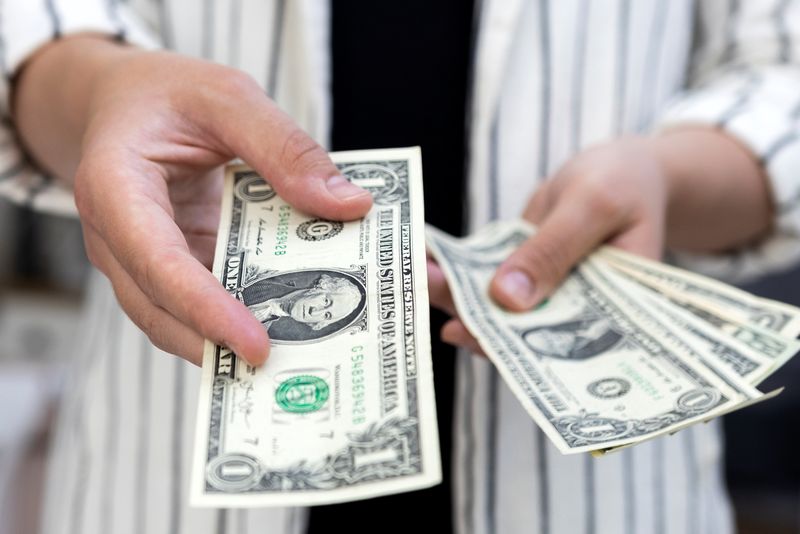Forex
Dollar slips in choppy trading as traders grapple with Fed’s giant rate cut

(Adds missing “cuts” in first bullet, no other changes to text)
By Chibuike Oguh and Stefano Rebaudo
NEW YORK (Reuters) – The U.S. dollar slipped in choppy trading on Wednesday as markets grappled with the supersized 50 basis point interest rate cut, as well as the switch to an easing monetary policy stance delivered by the Federal Reserve.
Investor expectations had largely shifted towards a dovish outcome in the days leading up to the Fed’s move on Wednesday, with money markets pricing in around a 65% chance of a 50 basis point (bp) cut. But economists polled by Reuters were leaning towards a 25 bp cut.
“The interesting thing is the half point cut, which was pretty much unexpected or at least only half and half yesterday, has not really given the dollar extra damage – which is quite surprising,” said Joseph Trevisani, senior analyst at FXStreet in New York.
The , which measures the greenback against a basket of six peers, was down 0.38% to 100.64 after reversing gains made in early trading. It slid to its lowest in more than a year of 100.21 in the previous session.
The euro strengthened 0.4% to $1.1163. Against the yen, the dollar was 0.33% higher at 142.73 as markets anticipate that the Bank of Japan will leave interest rates unchanged on Friday.
The dollar weakened 0.08% to 0.847 against the Swiss franc and dropped 0.34% to 7.070 versus the offshore .
“What it’s really doing I think is giving permission, if you will, for the other central banks around the world, some of whom have started to cut rates already, to go further with their rate cuts,” Trevisani said.
Money markets priced in 72 bps of additional rate cuts in 2024 and 192 bps by September 2025.
The U.S. Treasury yield curve, which measures the gap between yields on two- and and seen as an indicator of economic expectations, steepened and hit its highest since June 2022. It was last at a positive 13.4 basis points, indicating more upcoming rate cuts.
Initial claims for state unemployment benefits dropped unexpectedly to 12,000 last week, according to Labor Department data on Thursday, suggesting labor market growth.
Fed policymakers on Wednesday projected the benchmark interest rate would fall by another half of a percentage point by the end of this year, a full percentage point next year and half of a percentage point in 2026.
“The initial interpretation of the decision was that it was dovish and while it was basically even odds that it was going to happen, overall, on the surface, it’s still a dovish move,” said Eugene Epstein, head of trading & structured products North America at Moneycorp in Boston.
“Everything reversed basically by the end of the day, so you can make the argument as a bit of buy the rumour, sell the fact. A lot of dovishness was already priced in.”
The pound hit its highest since March 2022 versus the dollar after the Bank of England’s Monetary Policy Committee (MPC) voted 8-1 to keep rates on hold. Sterling was up 0.5% against the greenback at $1.3278 after reaching as high as $1.3314.
The Australian and New Zealand dollars drew support from domestic data surprises. Australian employment exceeded forecasts for a third straight month in August.
The was up 0.77% to $0.6815.
The , meanwhile, traded 0.58% higher at $0.6244, after data showed the New Zealand economy contracted by 0.2% in the second quarter.
Currency bid prices at 19
September 07:17 p.m. GMT
Description RIC Last U.S. Close Previous Session Pct Change YTD Pct High Bid Low Bid
Dollar index 100.62 101.02 -0.39% -0.74% 101.47 100.51
Euro/Dollar 1.1162 1.1118 0.4% 1.13% $1.1179 $1.1069
Dollar/Yen 142.61 142.3 0.22% 1.11% 143.875 141.885
Euro/Yen 1.1162 158.18 0.64% 2.29% 159.96 157.79
Dollar/Swiss 0.8469 0.8463 0.06% 0.62% 0.8515 0.845
Sterling/Dollar 1.3276 1.3214 0.51% 4.37% $1.3314 $1.3155
Dollar/Canadian 1.3559 1.3606 -0.34% 2.29% 1.3648 1.3534
Aussie/Dollar 0.6812 0.6764 0.73% -0.07% $0.6839 $0.6738
Euro/Swiss 0.945 0.9408 0.47% 1.79% 0.9465 0.9406
Euro/Sterling 0.8406 0.8414 -0.1% -3.02% 0.8423 0.8392
NZ Dollar/Dollar 0.6243 0.6208 0.65% -1.12% $0.6269 0.6183
Dollar/Norway 10.4931 10.5877 -0.89% 3.53% 10.6504 10.4394
Euro/Norway 11.7134 11.7726 -0.5% 4.36% 11.7929 11.6517
Dollar/Sweden 10.1611 10.2057 -0.44% 0.93% 10.2535 10.1143

Euro/Sweden 11.3423 11.3478 -0.05% 1.95% 11.3597 11.2923
(This story has been refiled to add the missing word ‘cuts’ in the first bullet)

 Forex3 years ago
Forex3 years agoForex Today: the dollar is gaining strength amid gloomy sentiment at the start of the Fed’s week

 Forex3 years ago
Forex3 years agoUnbiased review of Pocket Option broker

 Forex3 years ago
Forex3 years agoDollar to pound sterling exchange rate today: Pound plummeted to its lowest since 1985

 Forex3 years ago
Forex3 years agoHow is the Australian dollar doing today?

 Cryptocurrency3 years ago
Cryptocurrency3 years agoWhat happened in the crypto market – current events today

 World3 years ago
World3 years agoWhy are modern video games an art form?

 Commodities3 years ago
Commodities3 years agoCopper continues to fall in price on expectations of lower demand in China

 Economy3 years ago
Economy3 years agoCrude oil tankers double in price due to EU anti-Russian sanctions





















